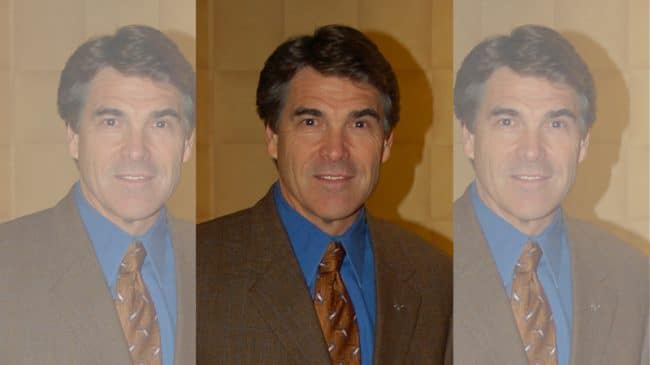The biggest problem with the energy plan that Rick Perry released recently is Rick Perry himself. Like a desperate used-car salesman, he is making such outlandish claims for it that his customers might walk out before taking a good look.
That, however, would be a pity, because the plan is actually better than any proposed by any president in recent memory.
The liberal blogosphere is up in arms against it because it stands for everything liberals despise. Unlike that other yahoo from Texas, George W. Bush, who made curing America’s “addiction to oil” a guiding principle, Perry is absolutely unapologetic about this “addiction.” To the contrary, rapidly exploiting America’s fossil fuel reserves-coal, oil, gas-is a key plank of his energy agenda.
To this end, he wants to:
• Expand oil drilling in the Gulf and the mid-Atlantic, as well as federal lands including Alaska’s hallowed Arctic National Wildlife Refuge.
• Blast out natural gas trapped in shale basins through a new process called fracking. Fracking, incidentally, can help America unlock enough clean-burning natural gas to replace all its coal-generated electricity for 70 years. Enviros initially welcomed this development-until they realized it would make their beloved renewables even more uncompetitive.
• Rescue coal, as abundant in the U.S. as oil is in Saudi Arabia, from President Obama’s greenhouse gas strictures, which make it prohibitively expensive.
Perry isn’t hostile to renewables. He insists he would use an “all of the above” energy strategy, including wind, solar, and biomass. But he won’t give them government handouts, something that every president, Democrat or Republican, has done since Gerald Ford.
He also promises to end federal subsidies for non-renewables. This is more easily said than done, given the complex web of direct and indirect tax breaks and subsidies that have long distorted the energy sector. One would take his promise more seriously if he offered more specifics, but his plan is blissfully vague. Still, it represents progress (of sorts) that he hasn’t identified any sacred cows for special protections.
However, the part that has liberals really foaming at the mouth is his suggestion to severely check the power of the EPA and give states more leeway to set their own environmental regulations. The standard criticism of such rollbacks is that states, released from Uncle Sam’s iron fist, will engage in a race to the bottom and gut environmental standards to attract business. But states have a far greater incentive than distant bureaucrats to look for ways to protect their natural resources with minimal sacrifice of economic and other priorities.
All in all, Perry’s plan offers a radical blueprint for energy liberalization. So what’s wrong it? His sales pitch.
For starters, precisely because it is so ambitious, it won’t be easy to pull off. But instead of leveling with the American public, Perry is exaggerating the plan’s political feasibility, claiming that most of it can be implemented by executive fiat without congressional action.
Take the EPA, for example. It was created to enforce duly enacted federal laws, such as the Clean Water Act and the Clean Air Act, whose constitutionality courts have long upheld. Rolling back the EPA’s authority over states will require congressional approval, something harder to come by, these days, than divine grace. Pretending otherwise is just dishonest.
What’s more, Perry is touting his energy plan as a jobs program, claiming that it will create 1.2 million jobs. This is not as wild as Obama’s promise of generating 5 million green jobs by shoveling stimulus money into politically-connected duds like Solyndra. However, job projections are notoriously difficult to make accurately, and there is every reason to believe that Perry’s claims, largely lifted from oil industry studies, are way off. Michael Levi, senior fellow for energy and environment at the Council on Foreign Relations, estimates that Perry’s plan will create 620,000 jobs at best. If Levi is right, Perry has needlessly opened himself up to attack by using inflated numbers. And for what? The main point of energy liberalization is not to create jobs. It’s to make cheap and reliable energy available to individuals and businesses. That’s the message that Perry should be hammering.
Perry touts his plan as the road to energy independence, and in this lies its fatal flaw. The world market sets energy prices, especially the prices of oil and gas. Energy won’t cost any less because it is made in America. Yes, America should tap its energy resources if it can do so competitively. If it can’t, it should buy energy from abroad, just as it does food, clothing, electronics, and every other commodity. Chanting an energy independence mantra will commit America to generating its own energy, eviscerating the entire initial rationale for energy liberalization: letting the market determine where and how to generate supply to meet demand.
Perry has a solid energy plan that can distinguish him from the pack and force a real debate on the issue. But he has to stop claiming that it can cure every American ill. He’s pouring good medicine into a snake oil bottle.
Reason Foundation Senior Analyst Shikha Dalmia is a columnist at The Daily where this column originally appeared.

